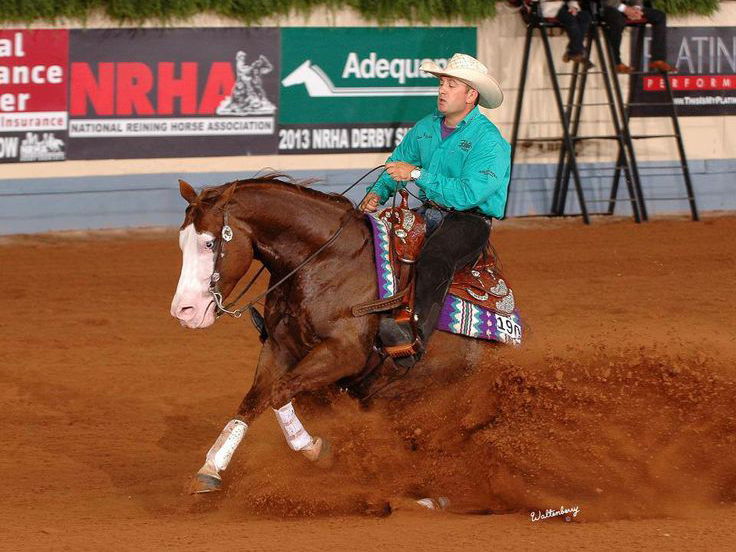Foal Treated For Leg Fracture At Texas A&M Goes On To Become Distinguished Reining Competitor
Story by Dorian Martin

Gunnin4Chicks boasts an enviable record in reining competitions, including winning and placing in the sport’s most prestigious events for over a decade. Yet his career performing in this very physically demanding western riding competition was nearly derailed before it ever started.
As a 2-month-old foal, the quarter horse colt suffered a devastating injury—a complete, displaced fracture of his left humerus.
Fortunately, owner Mark Bradford found the only veterinarians in the world with the expertise to have successfully treated this injury in multiple foals—Dr. Jeffrey Watkins and Dr. Kati Glass, of Texas A&M College of Veterinary Medicine & Biomedical Sciences’ (VMBS) Large Animal Teaching Hospital (LATH). The LATH team successfully repaired Gunnin4Chicks’ fractured humerus, inserting a specialized medical implant that Watkins had developed specifically to treat this type of equine injury.
Now at an age when his counterparts are enjoying retirement, the 13-year-old stallion is still competing at an elite level. He recently participated in The Run For A Million reining competition, Aug. 17-20, in Las Vegas.
Bradford credits LATH’s team with making Gunnin4Chicks’ remarkable and lengthy career possible.
“I couldn’t recommend Dr. Watkins, Dr. Glass, and their team any higher,” the owner said. “That surgery gave my horse the opportunity to be the best he could be.”
Innovation For Healing
No one knows how Gunnin4Chicks fractured his humerus in 2009, but it was immediately evident that the horse could not put weight on his left leg. While many fractures of this type in other bones can be repaired with plates and screws, the humerus does not lend itself to similar techniques.
Bradford immediate took the foal to his veterinarian, a Dallas-area equine orthopedic surgeon. After concluding the examination, Bradford clearly remembered the verdict: “My veterinarian said Dr. Watkins was the only guy who could fix it.”
Fortunately, the injury that Gunnin4Chicks suffered was exactly the type of medical problem that Watkins has focused his career on solving. Years earlier, the Texas A&M veterinarian had met biomedical engineer Rich Ashman when both were working on a project at Texas Scottish Rite Hospital for Children.
“At that time, and even today, many foals suffering a fractured humerus are humanely euthanized,” Watkins said. “Although interlocking nails were becoming state-of-the-art for repairing fractures in people, human interlocking nails were’t suitable for horses because the dimensions were different, they weren’t strong enough, and they required specialized equipment that wasn’t readily available to most veterinary surgeons at the time.”
Watkins and Ashman teamed up to find the elusive solution. Together, Watkins and Ashman developed an interlocking nail that could be placed inside the horse’s humerus and secured with screws. This medical device holds the bone in position, allowing it to heal.
“The bone has the capacity to completely regenerate and be as strong or stronger than it was,” Watkins explained.
Watkins began to use this device to repair humerus fractures in foals—and found over time that the procedure had an 80% success rate, and has even been used to treat a polar bear. Watkins hopes to someday make this device and the surgical procedure readily available to veterinary surgeons worldwide.
Full Recovery

Within days after the operation, Gunnin4Chicks was putting weight on the left leg.
“He could bear his full weight while healing the fracture,” Watkins said, adding that the horse soon was moving without any difficulty.
The horse also left Texas A&M with something else important beyond his mobility.
“He was 6 weeks old when Texas A&M’s team came up with his name, Gunnin4Chicks,” Bradford remembered, noting that the horse’s parents were Colonels Smoking Gun and Dun It by Chick.
A few years later, Bradford decided to enter Gunnin4Chicks in reining events—and soon learned that he had a “superstar little horse.” The distinctive horse with a white face and blue eyes won the first show he competed in and has consistently won or placed ever since. His lifetime earnings are around $80,000.
While Bradford has limited the number of competitions as the horse has aged, Gunnin4Chicks still is passionate about reining.
“He loves the show pen and likes competing,” the owner said, adding that most horses’ reining careers end when they are age 6. “He wants a job and wants to work. He’s such a happy horse and he gives you more than you want. He’s a sweet horse with a heart like a lion.”
Pleased to see Gunnin4Chicks still performing at a high level, Watkins said the stallion serves as an important example of what is possible with the proper surgical care.
“It’s gratifying that this horse went on and had an illustrious career after we fixed the fracture,” the Texas A&M veterinarian said. “There’s a misconception about what happens to a horse who breaks a leg, but that’s an outdated story. There are surgical options for these horses, and in many cases, their career as a performance horse be salvaged”
###
For more information about the Texas A&M School of Veterinary Medicine & Biomedical Sciences, please visit our website at vetmed.tamu.edu or join us on Facebook, Instagram, and Twitter.
Contact Information: Jennifer Gauntt, Director of VMBS Communications, Texas A&M School of Veterinary Medicine & Biomedical Sciences, jgauntt@cvm.tamu.edu, 979-862-4216


